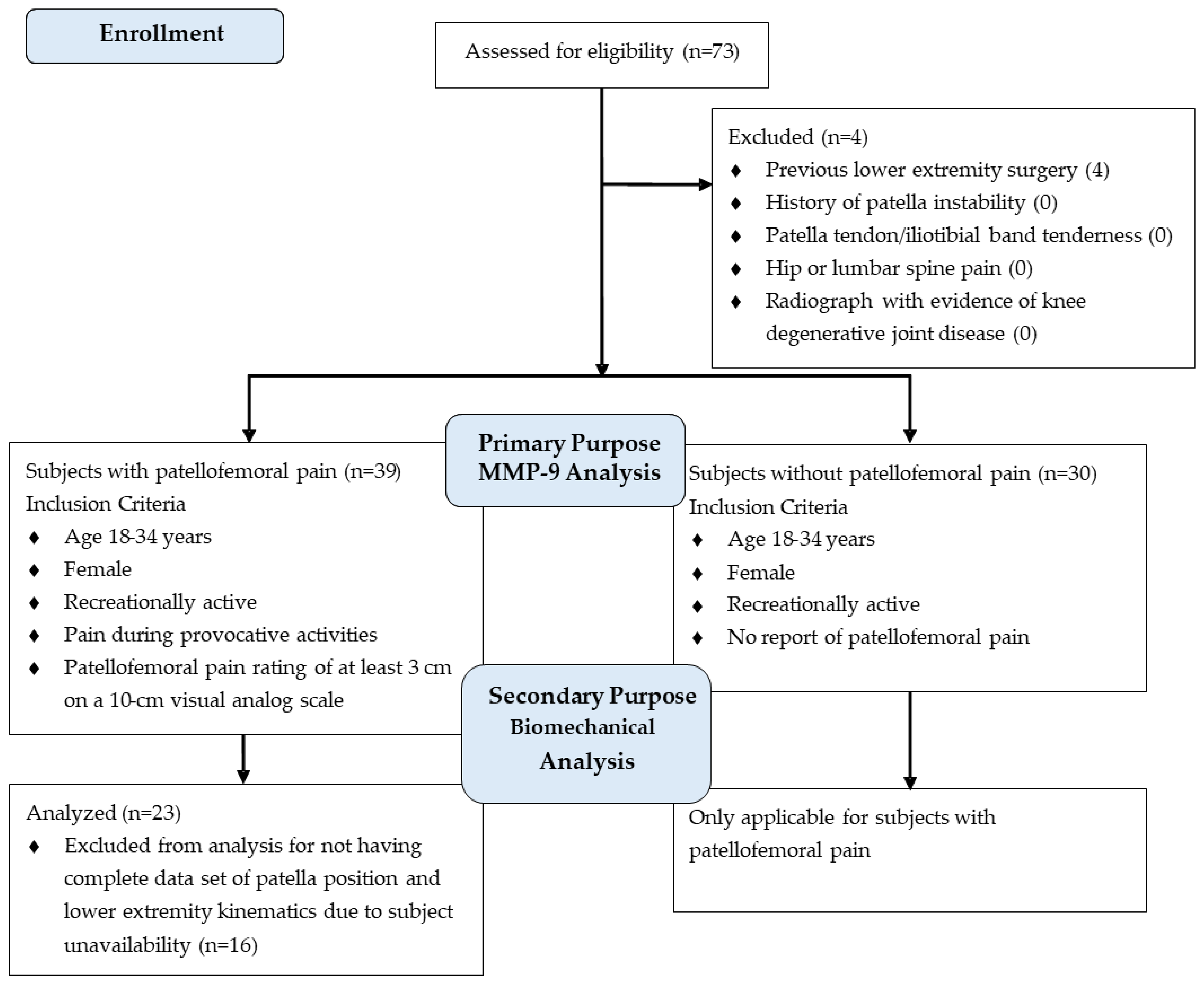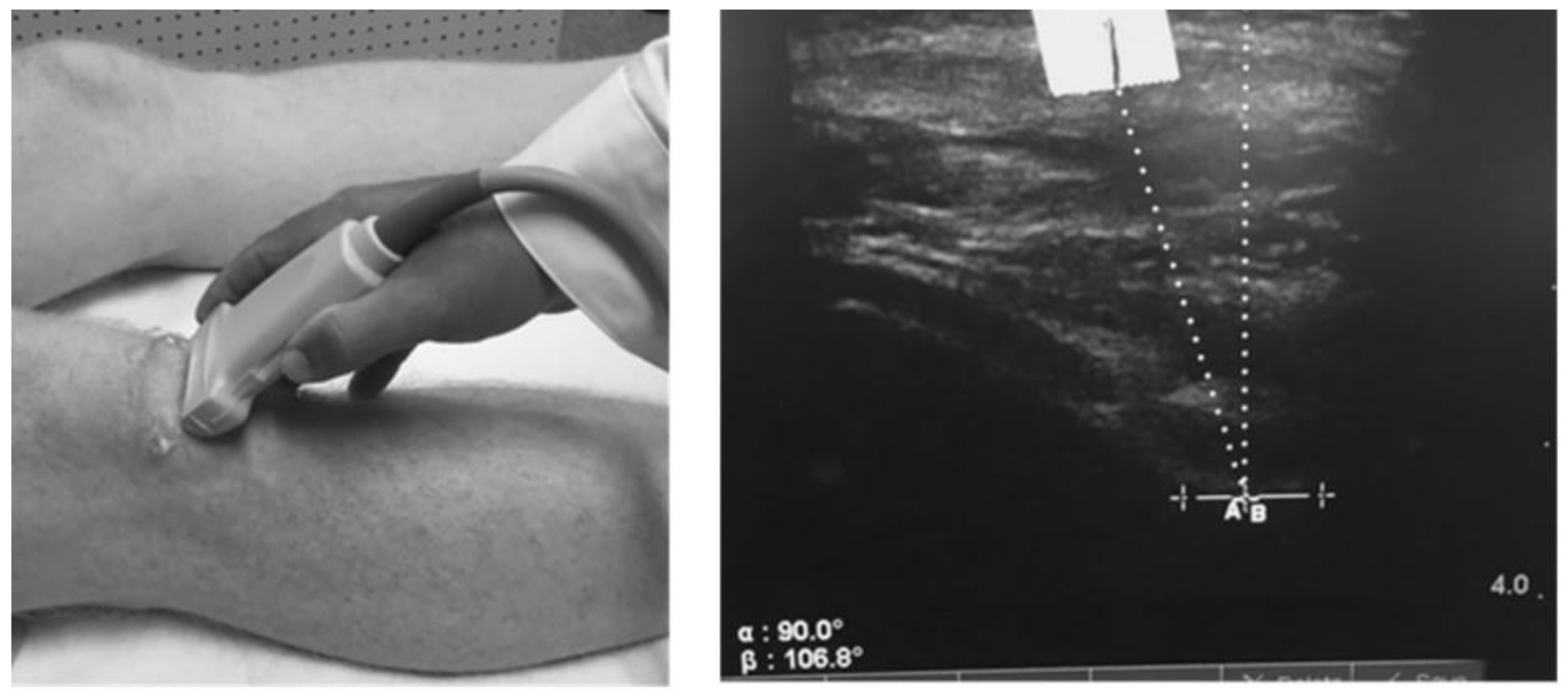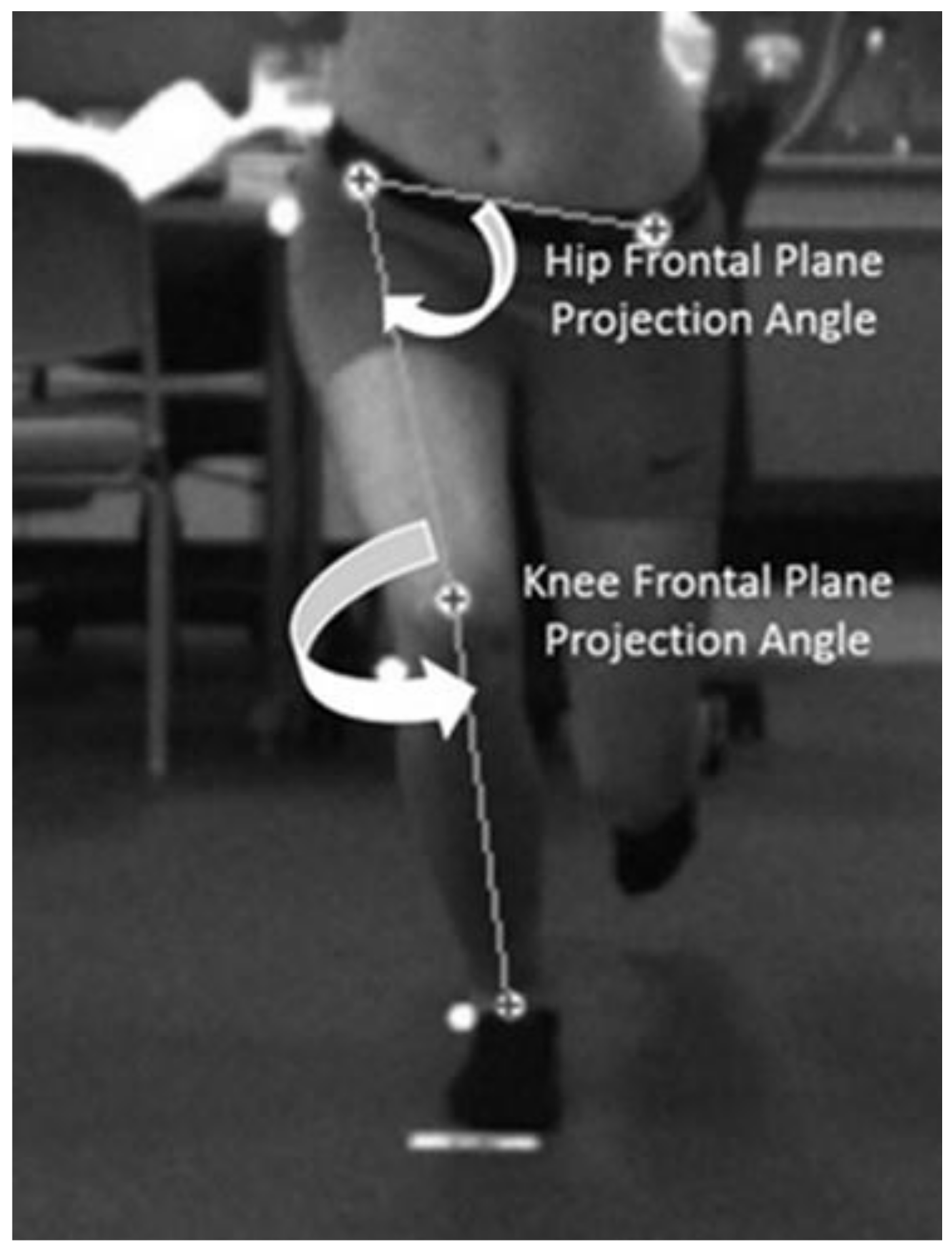Comparison of Inflammatory Biomarkers in Females with and Without Patellofemoral Pain and Associations with Patella Position, Hip and Knee Kinematics, and Pain
Abstract
1. Introduction
2. Materials and Methods
2.1. Research Design
2.2. Subjects
2.3. Plasma Collection and Measurement of MMP-9 Levels
2.4. Static Patella Position
2.5. Hip and Knee Kinematics During a Single-Leg Squat
2.6. Statistical Analysis
3. Results
3.1. Subject Characteristics
3.2. Comparison of MMP-9 Levels in Females with PFP and Control
3.3. Associations Between MMP-9 Levels, RAB Angle, DVI, and Pain in Females with PFP
4. Discussion
4.1. Comparison of MMP-9 Levels in Females with PFP and Control
4.2. Associations Between MMP-9 Levels, Pain, RAB Angle, and DVI in Females with PFP
4.3. Limitations
4.4. Future Directions and Conclusion
Author Contributions
Funding
Institutional Review Board Statement
Informed Consent Statement
Data Availability Statement
Conflicts of Interest
References
- Steinmetz, J.D.; Culbreth, G.T.; Haile, L.M.; Rafferty, Q.; Lo, J.; Fukutaki, K.G.; Cruz, J.A.; Smith, A.E.; Vollset, S.E.; Brooks, P.M.; et al. GBD 2021 Osteoarthritis Collaborators. Global, regional, and national burden of osteoarthritis, 1990–2020 and projections to 2050: A systematic analysis for the Global Burden of Disease Study 2021. Lancet Rheumatol. 2023, 5, e508–e522. [Google Scholar] [CrossRef] [PubMed]
- Hame, S.L.; Alexander, R.A. Knee osteoarthritis in women. Curr. Rev. Musculoskelet. Med. 2013, 6, 182–187. [Google Scholar] [CrossRef] [PubMed]
- Lawrence, R.C.; Felson, D.T.; Helmick, C.G.; Arnold, L.M.; Choi, H.; Deyo, R.A.; Gabriel, S.; Hirsch, R.; Hochberg, M.C.; Hunder, G.G.; et al. Estimates of the prevalence of arthritis and other rheumatic conditions in the United States. Part II. Arthritis Rheum. 2008, 58, 26–35. [Google Scholar] [CrossRef] [PubMed]
- Vitaloni, M.; Botto-van Bemden, A.; Sciortino Contreras, R.M.; Scotton, D.; Bibas, M.; Quintero, M.; Monfort, J.; Carné, X.; de Abajo, F.; Oswald, E.; et al. Global management of patients with knee osteoarthritis begins with quality of life assessment: A systematic review. BMC Musculoskelet. Disord. 2019, 20, 493. [Google Scholar] [CrossRef]
- Pazzinatto, M.F.; Silva, D.O.; Willy, R.W.; Azevedo, F.M.; Barton, C.J. Fear of movement and (re)injury is associated with condition specific outcomes and health-related quality of life in women with patellofemoral pain. Physiother. Theory Pract. 2022, 38, 1254–1263. [Google Scholar] [CrossRef]
- Glaviano, N.R.; Kew, M.; Hart, J.M.; Saliba, S. Demographic and epidemiological trends in patellofemoral pain. Int. J. Sports Phys. Ther. 2015, 10, 281–290. [Google Scholar]
- Willy, R.W.; Hoglund, L.T.; Barton, C.J.; Bolgla, L.A.; Scalzitti, D.A.; Logerstedt, D.S.; Lynch, A.D.; Snyder-Mackler, L.; McDonough, C.M. Patellofemoral Pain. J. Orthop. Sports Phys. Ther. 2019, 49, CPG1–CPG95. [Google Scholar] [CrossRef]
- Sánchez, M.B.; Selfe, J.; Callaghan, M.J. The prevalence of patellofemoral pain in the Rugby League World Cup (RLWC) 2021 spectators: A protocol of a cross-sectional study. PLoS ONE 2021, 16, e0260541. [Google Scholar] [CrossRef]
- Rothermich, M.A.; Glaviano, N.R.; Li, J.; Hart, J.M. Patellofemoral pain: Epidemiology, pathophysiology, and treatment options. Clin. Sports Med. 2015, 34, 313–327. [Google Scholar] [CrossRef]
- Crossley, K.M.; Callaghan, M.J.; Linschoten, R. Patellofemoral pain. Br. J. Sports Med. 2016, 50, 247–250. [Google Scholar] [CrossRef]
- Eijkenboom, J.F.A.; Waarsing, J.H.; Oei, E.H.G.; Bierma-Zeinstra, S.M.A.; van Middelkoop, M. Is patellofemoral pain a precursor to osteoarthritis?: Patellofemoral osteoarthritis and patellofemoral pain patients share aberrant patellar shape compared with healthy controls. Bone Joint Res. 2018, 7, 541–547. [Google Scholar] [CrossRef] [PubMed]
- Antony, B.; Jones, G.; Jin, X.; Ding, C. Do early life factors affect the development of knee osteoarthritis in later life: A narrative review. Arthritis Res. Ther. 2016, 18, 202. [Google Scholar] [CrossRef]
- Brenneis, M.; Junker, M.; Sohn, R.; Braun, S.; Ehnert, M.; Zaucke, F.; Jenei-Lanzl, Z.; Meurer, A. Patellar malalignment correlates with increased pain and increased synovial stress hormone levels-A cross-sectional study. PLoS ONE 2023, 18, e0289298. [Google Scholar] [CrossRef] [PubMed]
- Smith, B.E.; Moffatt, F.; Hendrick, P.; Bateman, M.; Rathleff, M.S.; Selfe, J.; Smith, T.O.; Logan, P. The experience of living with patellofemoral pain-loss, confusion and fear-avoidance: A UK qualitative study. BMJ Open 2018, 8, e018624. [Google Scholar] [CrossRef]
- Maclachlan, L.R.; Collins, N.J.; Hodges, P.W.; Vicenzino, B. Psychological and pain profiles in persons with patellofemoral pain as the primary symptom. Eur. J. Pain 2020, 24, 1182–1196. [Google Scholar] [CrossRef]
- Hott, A.; Brox, J.I.; Pripp, A.H.; Juel, N.G.; Liavaag, S. Predictors of pain, function, and change in patellofemoral pain. Am. J. Sports Med. 2020, 48, 351–358. [Google Scholar] [CrossRef]
- Priore, L.B.; Azevedo, F.M.; Pazzinatto, M.F.; Ferreira, A.S.; Hart, H.F.; Barton, C.; de Oliveira Silva, D. Influence of kinesiophobia and pain catastrophism on objective function in women with patellofemoral pain. Phys. Ther. Sport 2019, 35, 116–121. [Google Scholar] [CrossRef]
- Glaviano, N.R.; Baellow, A.; Saliba, S. Physical activity levels in individuals with and without patellofemoral pain. Phys. Ther. Sport 2017, 27, 12–16. [Google Scholar] [CrossRef]
- Glaviano, N.R.; Holden, S.; Bazett-Jones, D.M.; Singe, S.M.; Rathleff, M.S. Living well (or not) with patellofemoral pain: A qualitative study. Phys. Ther. Sport 2022, 56, 1–7. [Google Scholar] [CrossRef]
- Post, W.R.; Dye, S.F. Patellofemoral pain: An enigma explained by homeostasis and common sense. Am. J. Orthop. 2017, 46, 92–100. [Google Scholar]
- Kim, Y.M.; Joo, Y.B. Patellofemoral osteoarthritis. Knee Surg. Relat. Res. 2012, 24, 193–200. [Google Scholar] [CrossRef] [PubMed]
- Wyndow, N.; Collins, N.; Vicenzino, B.; Tucker, K.; Crossley, K. Is there a biomechanical link between patellofemoral pain and osteoarthritis? A narrative review. Sports Med. 2016, 46, 1797–1808. [Google Scholar] [CrossRef] [PubMed]
- Powers, C.M. The influence of abnormal hip mechanics on knee injury: A biomechanical perspective. J. Orthop. Sports Phys. Ther. 2010, 40, 42–51. [Google Scholar] [CrossRef] [PubMed]
- Salsich, G.B.; Graci, V.; Maxam, D.E. The effects of movement pattern modification on lower extremity kinematics and pain in women with patellofemoral pain. J. Orthop. Sports Phys. Ther. 2012, 42, 1017–1024. [Google Scholar] [CrossRef]
- Powers, C.M. The influence of altered lower-extremity kinematics on patellofemoral joint dysfunction: A theoretical perspective. J. Orthop. Sports Phys. Ther. 2003, 33, 639–646. [Google Scholar] [CrossRef]
- Lee, T.Q.; Morris, G.; Csintalan, R.P. The influence of tibial and femoral rotation on patellofemoral contact area and pressure. J. Orthop. Sports Phys. Ther. 2003, 33, 686–693. [Google Scholar] [CrossRef]
- Collins, N.J.; Oei, E.H.G.; de Kanter, J.L.; Vicenzino, B.; Crossley, K.M. Prevalence of radiographic and magnetic resonance imaging features of patellofemoral osteoarthritis in young and middle-aged adults with persistent patellofemoral pain. Arthritis Care Res. 2019, 71, 1068–1073. [Google Scholar] [CrossRef]
- Poole, A.R. Can serum biomarker assays measure the progression of cartilage degeneration in osteoarthritis? Arthritis Rheum. 2002, 46, 2549–2552. [Google Scholar] [CrossRef]
- Van der Heijden, R.A.; de Kanter, J.L.; Bierma-Zeinstra, S.M.; Verhaar, J.A.; van Veldhoven, P.L.; Krestin, G.P.; Oei, E.H.; van Middelkoop, M. Structural abnormalities on magnetic resonance imaging in patients with patellofemoral pain: A cross-sectional case-control study. Am. J. Sports Med. 2016, 44, 2339–2346. [Google Scholar] [CrossRef]
- Van der Heijden, R.A.; Oei, E.H.; Bron, E.E.; van Tiel, J.; van Veldhoven, P.L.; Klein, S.; Verhaar, J.A.; Krestin, G.P.; Bierma-Zeinstra, S.M.; van Middelkoop, M. No difference on quantitative magnetic resonance imaging in patellofemoral cartilage composition between patients with patellofemoral pain and healthy controls. Am. J. Sports Med. 2016, 44, 1172–1178. [Google Scholar] [CrossRef]
- Slovacek, H.; Khanna, R.; Poredos, P.; Jezovnik, M.; Hoppensteadt, D.; Fareed, J.; Hopkinson, W. Interrelationship of Osteopontin, MMP-9 and ADAMTS4 in Patients with Osteoarthritis Undergoing Total Joint Arthroplasty. Clin. Appl. Thromb. Hemost. 2020, 26, 1076029620964864. [Google Scholar] [CrossRef] [PubMed]
- Zeng, G.Q.; Chen, A.B.; Li, W.; Song, J.H.; Gao, C.Y. High MMP-1, MMP-2, and MMP-9 protein levels in osteoarthritis. Genet. Mol. Res. 2015, 14, 14811–14822. [Google Scholar] [CrossRef] [PubMed]
- Favero, M.; Ramonda, R.; Goldring, M.B.; Goldring, S.R.; Punzi, L. Early knee osteoarthritis. RMD Open 2015, 1, e000062. [Google Scholar] [CrossRef]
- Li, S.; Wang, H.; Zhang, Y.; Qiao, R.; Xia, P.; Kong, Z.; Zhao, H.; Yin, L. COL3A1 and MMP9 Serve as Potential Diagnostic Biomarkers of Osteoarthritis and Are Associated with Immune Cell Infiltration. Front. Genet. 2021, 12, 721258. [Google Scholar] [CrossRef] [PubMed]
- Yu, L.; Luo, R.; Qin, G.; Zhang, Q.; Liang, W. Efficacy and safety of anti-interleukin-1 therapeutics in the treatment of knee osteoarthritis: A systematic review and meta-analysis of randomized controlled trials. J. Orthop. Surg. Res. 2023, 18, 100. [Google Scholar] [CrossRef] [PubMed]
- Crossley, K.M.; van Middelkoop, M.; Barton, C.J.; Culvenor, A.G. Rethinking patellofemoral pain: Prevention, management and long-term consequences. Best Pract. Res. Clin. Rheumatol. 2019, 33, 48–65. [Google Scholar] [CrossRef]
- Boling, M.; Padua, D.; Marshall, S.; Guskiewicz, K.; Pyne, S.; Beutler, A. Gender differences in the incidence and prevalence of patellofemoral pain syndrome. Scand. J. Med. Sci. Sports 2010, 20, 725–730. [Google Scholar] [CrossRef]
- Ferber, R.; Bolgla, L.; Earl-Boehm, J.E.; Emery, C.; Hamstra-Wright, K. Strengthening of the hip and core versus knee muscles for the treatment of patellofemoral pain: A multicenter randomized controlled trial. J. Athl. Train. 2015, 50, 366–377. [Google Scholar] [CrossRef]
- Mouritzen, U.; Christgau, S.; Lehmann, H.J.; Tankó, L.B.; Christiansen, C. Cartilage turnover assessed with a newly developed assay measuring collagen type II degradation products: Influence of age, sex, menopause, hormone replacement therapy, and body mass index. Ann. Rheum. Dis. 2003, 62, 332–336. [Google Scholar] [CrossRef]
- Cui, A.; Li, H.; Wang, D.; Zhong, J.; Chen, Y.; Lu, H. Global, regional prevalence, incidence and risk factors of knee osteoarthritis in population-based studies. eClinicalMedicine 2020, 29–30, 100587. [Google Scholar] [CrossRef]
- Gwynne, C.R.; Curran, S.A. Two-dimensional frontal plane projection angle can identify subgroups of patellofemoral pain patients who demonstrate dynamic knee valgus. Clin. Biomech. 2018, 58, 44–48. [Google Scholar] [CrossRef] [PubMed]
- Crossley, K.M.; Bennell, K.L.; Cowan, S.M.; Green, S. Analysis of outcome measures for persons with patellofemoral pain: Which are reliable and valid? Arch. Phys. Med. Rehabil. 2004, 85, 815–822. [Google Scholar] [CrossRef] [PubMed]
- Anillo, R.; Villanueva, E.; León, D.; Pena, A. Ultrasound diagnosis for preventing knee injuries in Cuban high-performance athletes. MEDICC Rev. 2009, 11, 21–28. [Google Scholar] [PubMed]
- Bolgla, L.A.; Gordon, R.; Sloan, G.; Pretlow, L.G.; Lyon, M.; Fulzele, S. Comparison of patella alignment and cartilage biomarkers in young adult females with and without patellofemoral pain: A pilot study. Int. J. Sports Phys. Ther. 2019, 14, 46–54. [Google Scholar]
- Scholtes, S.A.; Salsich, G.B. A dynamic valgus index that combines hip and knee angles: Assessment of utility in females with patellofemoral pain. Int. J. Sports Phys. Ther. 2017, 12, 333–340. [Google Scholar]
- Bolgla, L.A.; Gibson, H.N.; Hannah, D.C.; Curry-McCoy, T. Comparison of the frontal plane projection angle and the dynamic valgus index to identify movement dysfunction in females with patellofemoral pain. Int J Sports Phys Ther 2023, 18, 619–625. [Google Scholar] [CrossRef]
- Fleming, K.K.; Bovaird, J.A.; Mosier, M.C.; Emerson, M.R.; LeVine, S.M.; Marquis, J.G. Statistical analysis of data from studies on experimental autoimmune encephalomyelitis. J. Neuroimmunol. 2005, 170, 71–84. [Google Scholar] [CrossRef]
- Hales, A.H. One-tailed tests: Let’s do this (responsibly). Psychol. Methods 2024, 29, 1209–1218. [Google Scholar] [CrossRef]
- Roemer, F.W.; Kwoh, C.K.; Fujii, T.; Hannon, M.J.; Boudreau, R.M.; Hunter, D.J.; Eckstein, F.; John, M.R.; Guermazi, A. From early radiographic knee osteoarthritis to joint arthroplasty: Determinants of structural progression and symptoms. Arthritis Care Res. 2018, 70, 1778–1786. [Google Scholar] [CrossRef]
- Stefanik, J.J.; Guermazi, A.; Roemer, F.W.; Peat, G.; Niu, J.; Segal, N.A.; Lewis, C.E.; Nevitt, M.; Felson, D.T. Changes in patellofemoral and tibiofemoral joint cartilage damage and bone marrow lesions over 7 years: The Multicenter Osteoarthritis Study. Osteoarthr. Cartil. 2016, 24, 1160–1166. [Google Scholar] [CrossRef]
- Murphy, E.; FitzGerald, O.; Saxne, T.; Bresnihan, B. Increased serum cartilage oligomeric matrix protein levels and decreased patellar bone mineral density in patients with chondromalacia patellae. Ann. Rheum. Dis. 2002, 61, 981–985. [Google Scholar] [PubMed]
- Cibere, J.; Zhang, H.; Garnero, P.; Poole, A.R.; Lobanok, T.; Saxne, T.; Kraus, V.B.; Way, A.; Thorne, A.; Wong, H.; et al. Association of biomarkers with pre-radiographically defined and radiographically defined knee osteoarthritis in a population-based study. Arthritis Rheum. 2009, 60, 1372–1380. [Google Scholar] [CrossRef] [PubMed]
- Kalichman, L.; Zhang, Y.; Niu, J.; Goggins, J.; Gale, D.; Felson, D.T.; Hunter, D.J. The association between patellar alignment and patellofemoral joint osteoarthritis features—An MRI study. Rheumatology 2007, 46, 1303–1308. [Google Scholar] [CrossRef] [PubMed]
- Van Cant, J. Unmasking the Culprit: Reframing Pain in Research and Management of Patellofemoral Pain. J. Orthop. Sports Phys. Ther. 2025, 55, 75–77. [Google Scholar] [CrossRef]
- Ibrahim, I.; Saba, E.; Saad, N.; Mohammed, D. Relation of interleukin-15 with the severity of primary knee osteoarthritis. Egypt Rheumatol. 2019, 46, 313–320. [Google Scholar] [CrossRef]
- Ismail, S.; Ibrahim, I.; Saad, N.; Saba, E. Relation of interleukin-21 with primary knee osteoarthritis severity and functional disability. World Med. J. 2020, 17, 69–78. [Google Scholar] [CrossRef]
- Kolhe, R.; Owens, V.; Sharma, A.; Lee, T.J.; Zhi, W.; Ghilzai, U.; Mondal, A.K.; Liu, Y.; Isales, C.M.; Hamrick, M.W.; et al. Sex-specific differences in extracellular vesicle protein cargo in synovial fluid of patients with osteoarthritis. Life 2020, 10, 337. [Google Scholar] [CrossRef]



| PFP * n = 39 | Controls * n = 30 | p-Value † | |
|---|---|---|---|
| Age, y | 23.2 ± 2.9 | 22.7 ± 3.7 | 0.58 |
| Mass, kg | 72.8 ± 25.8 | 64.7 ± 11.6 | 0.12 |
| Height, cm | 162.3 ± 19.8 | 165.3 ± 5.4 | 0.42 |
| Pain, cm | 3.9 ± 1.2 | 0.0 | 0.001 |
| PFP | Controls | p-Value † | |
|---|---|---|---|
| MMP-9, ng/mL | 72.7 ± 38.3 | 58.0 ± 27.3 | 0.03 |
| RAB angle, degrees | 14.6 ± 8.7 | N/A * | N/A |
| DVI, degrees | 34.5 ± 11.6 | N/A | N/A |
| VAS, cm | 3.9 ± 1.2 | 0.0 | 0.001 |
| MMP-9 | RAB | DVI | VAS | |
|---|---|---|---|---|
| MMP-9 | 1 | 0.38 * | −0.50 † | 0.12 |
| RAB angle | 1 | −0.27 | 0.07 | |
| DVI | 1 | −0.13 | ||
| VAS | 1 |
| MMP-9 | RAB | DVI | VAS | |
|---|---|---|---|---|
| MMP-9 | 1 | 0.52 * | −0.78 † | 0.38 |
| RAB angle | 1 | −0.54 * | 0.32 | |
| DVI | 1 | −0.48 β | ||
| VAS | 1 |
Disclaimer/Publisher’s Note: The statements, opinions and data contained in all publications are solely those of the individual author(s) and contributor(s) and not of MDPI and/or the editor(s). MDPI and/or the editor(s) disclaim responsibility for any injury to people or property resulting from any ideas, methods, instructions or products referred to in the content. |
© 2025 by the authors. Licensee MDPI, Basel, Switzerland. This article is an open access article distributed under the terms and conditions of the Creative Commons Attribution (CC BY) license (https://creativecommons.org/licenses/by/4.0/).
Share and Cite
Bolgla, L.A.; Purohit, S.; Hannah, D.C.; Hunter, D.M. Comparison of Inflammatory Biomarkers in Females with and Without Patellofemoral Pain and Associations with Patella Position, Hip and Knee Kinematics, and Pain. Biomedicines 2025, 13, 761. https://doi.org/10.3390/biomedicines13030761
Bolgla LA, Purohit S, Hannah DC, Hunter DM. Comparison of Inflammatory Biomarkers in Females with and Without Patellofemoral Pain and Associations with Patella Position, Hip and Knee Kinematics, and Pain. Biomedicines. 2025; 13(3):761. https://doi.org/10.3390/biomedicines13030761
Chicago/Turabian StyleBolgla, Lori A., Sharad Purohit, Daniel C. Hannah, and David Monte Hunter. 2025. "Comparison of Inflammatory Biomarkers in Females with and Without Patellofemoral Pain and Associations with Patella Position, Hip and Knee Kinematics, and Pain" Biomedicines 13, no. 3: 761. https://doi.org/10.3390/biomedicines13030761
APA StyleBolgla, L. A., Purohit, S., Hannah, D. C., & Hunter, D. M. (2025). Comparison of Inflammatory Biomarkers in Females with and Without Patellofemoral Pain and Associations with Patella Position, Hip and Knee Kinematics, and Pain. Biomedicines, 13(3), 761. https://doi.org/10.3390/biomedicines13030761






